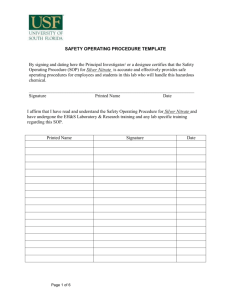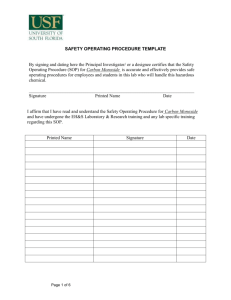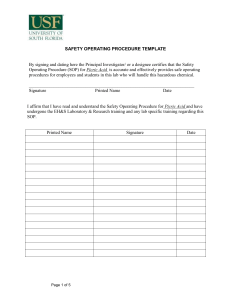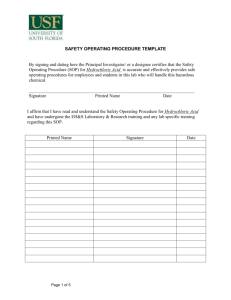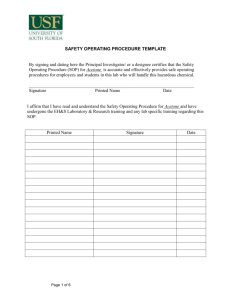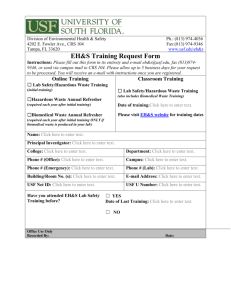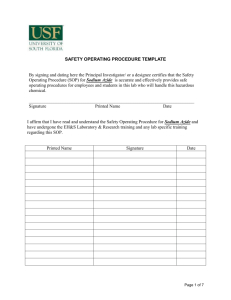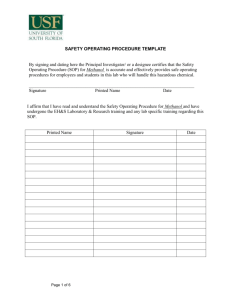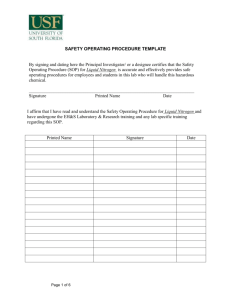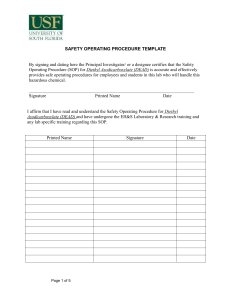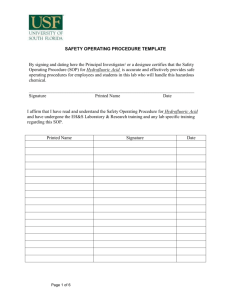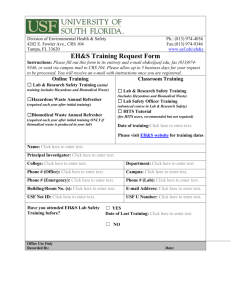Nitric Acid
advertisement
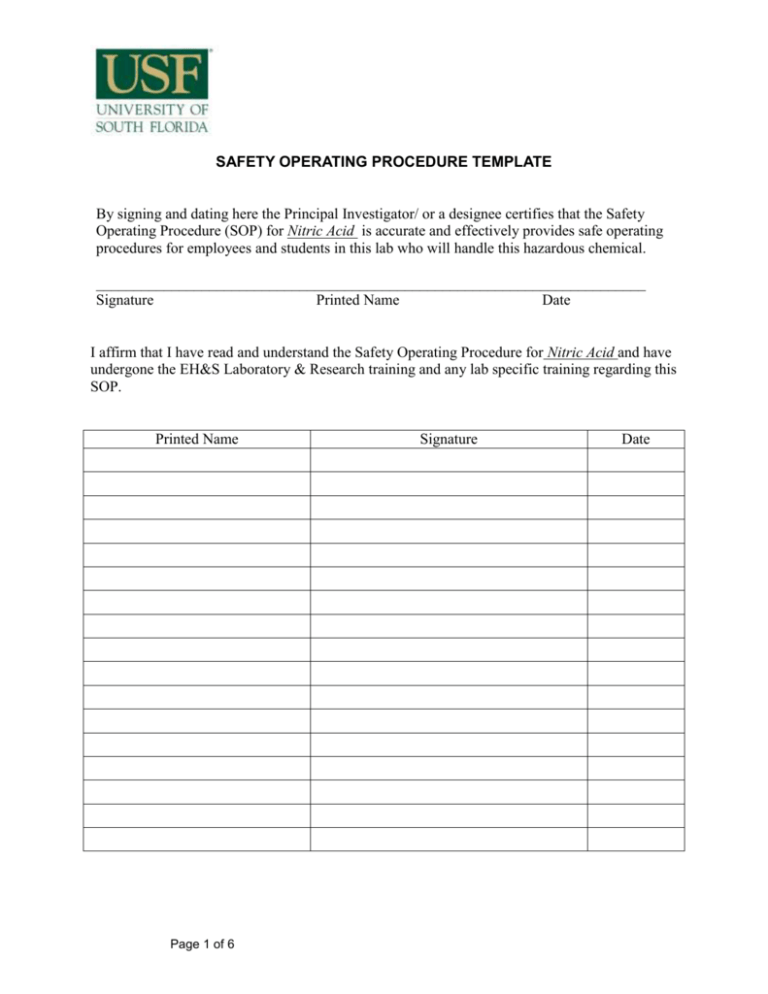
SAFETY OPERATING PROCEDURE TEMPLATE By signing and dating here the Principal Investigator/ or a designee certifies that the Safety Operating Procedure (SOP) for Nitric Acid is accurate and effectively provides safe operating procedures for employees and students in this lab who will handle this hazardous chemical. _________________________________________________________________________ Signature Printed Name Date I affirm that I have read and understand the Safety Operating Procedure for Nitric Acid and have undergone the EH&S Laboratory & Research training and any lab specific training regarding this SOP. Printed Name Page 1 of 6 Signature Date CONTACT INFORMATION: Nitric Acid Chemical Name: Building/Room Number: Date of Creation/Revision 8/2/2012 Principal Investigator: Emergency Phone number: HAZARD SUMMARY Potential physical and health hazards associated with the use of this chemical include: Danger! Strong oxidizer. May be fatal if inhaled. Causes severe eye skin, respiratory and digestive tract burns. Contact with other material may cause a fire. Acute pulmonary edema or chronic obstructive lung disease may occur from inhalation of the vapors of nitric acid. Corrosive to metal. When heated to decomposition it emits toxic nitrogen oxides fumes and hydrogen nitrate. Will react with water or steam to produce heat and toxic and corrosive fumes. SPECIAL HANDLING AND STORAGE REQUIREMENTS Describe special handling and storage requirements for this hazardous chemical in your laboratory, i.e. restricted access to chemical, inclusion of designated areas to limit and minimize possible sources of exposure to these materials. The entire laboratory, a portion of the laboratory, or a laboratory fume hood or bench may be considered a designated area. Special handling and storage requirements for this chemical include: Handling: Wash thoroughly after handling. Remove contaminated clothing and wash before reuse. Do not breathe dust, mist, or vapor. Do not get in eyes, on skin, or on clothing. Keep container tightly closed. Avoid contact with clothing and other combustible materials. Do not use with metal spatula or other metal items. Use only with adequate ventilation or respiratory protection. Storage: Always store chemical in secondary containment. Store in a cool, dry, well-ventilated area away from incompatible substances. Do not store near combustible materials or in direct sunlight. Keep container closed when not in use. Inspect periodically for damage or evidence of leaks or corrosion. Do not let dust accumulate where nitric acid is stored. Store in the fume hood when in use. Page 2 of 6 Keep away from metals, alkalines, and organic materials. It is non-corrosive in the presence of glass, most stainless steel and brass. Contaminated clothing and PPE should be washed at an appropriate facility before reuse. This substance is not to be put down the drain, or placed in the trash. Discard contaminated shoes. Wash hands and face thoroughly after handling and before work breaks, drinking, eating and smoking. Store Nitric Acid in secondary containment away from light, heat, and combustible materials. Secondary containment is a must if storing it within the Acids cabinet. Work with this chemical in approved working areas where environmental controls can be utilized, e.g. a corrosion-resistant ventilation system. ENGINEERING AND VENTILATION CONTROLS Include requirements for specific engineering/ventilation controls for this specific chemical, i.e. fume hood. If the process does not permit the handling of such materials in a fume hood, the lab personnel should contact Environmental Health and Safety at x4-4036 for review the adequacy of ventilation measures. Handling processes should be designed to minimize the potential for splash, splatter, or other likely scenarios for accidental contact. The handling of this chemical must be conducted in a fume hood. Additional engineering/ventilation controls for the handling of this chemical include: Facilities should be equipped with an eyewash facility and a safety shower. Ventilation Controls: Use a corrosion-resistant ventilation system to keep airborne concentrations below the permissible exposure limits. A system of local and/or general exhaust is recommended to keep employee exposures below the Airborne Exposure Limits. Local exhaust ventilation is generally preferred because it can control the emissions of the contaminant at its source, preventing dispersion of it into the general work area. PERSONAL PROTECTIVE EQUIPMENT Include specific personal protective equipment required for the handling of this chemical. See the following references: 1. The USF Hazardous Inventory Tracking System (HITS) provides access to MSDS. 2. A glove compatibility chart provides specific information on the type of safety gloves that should be used based on the hazards of specific chemicals. 3. The following EH&S webpage provides links to glove manufacturers as well as other PPE selection resources, http://usfweb2.usf.edu/eh&s/labsafety/links.html. At minimum, safety glasses, lab coat, and gloves are to be worn when using this hazardous chemical. Additional PPE Requirements for the handling of this chemical include: appropriate clothing (long pants, close-toed shoes) gloves; indicate type:______________________________ safety goggles face shield Page 3 of 6 □ □ flame-resistant lab coats other:__________________________ If the use of an N95, half mask, or full face respirator is requested, the individual and/or their supervisor must first contact Environmental Health & Safety for a consultation to determine if respirator use is necessary. If EH&S determines the use of a respirator is necessary, the individual must participate in the University’s respirator program. This includes a medical evaluation; respirator fit test, and training. Eyes: Wear chemical splash goggles and face shield. Skin: Wear butyl rubber gloves, apron, lab coat or coveralls, appropriate clothing to prevent skin exposure, and closed toed shoes. Respirator (NIOSH approved): If the exposure limit is exceeded, or if irritation or other symptoms are experienced, wear a supplied air, full-face piece respirator, air lined hood, or full-face piece self-contained breathing apparatus. Nitric acid is an oxidizer and should not come in contact with cartridges and canisters that contain oxidizable materials, such as activated charcoal. Canister-type respirators using sorbents are ineffective. EMERGENCY PROCEDURES If a there is a spill involving an extremely hazardous chemical, emergency responders should be contacted immediately. Dial 911 during and after normal business hours to contact the local emergency responders for your area and provide detail information to the emergency responders including chemical name, volume, hazards, spill location, and any injuries incurred. Building occupants can be notified of a building evacuation through the activation of a fire alarm pull station. Personnel: If lab personnel are exposed to an extremely hazardous chemical, call 911 immediately. Remove any contaminated clothing, and IMMEDIATELY flush contaminated skin with water for at least 15 minutes following any skin contact. For eye exposures, IMMEDIATELY flush eyes with water for at least 15 minutes. Consult MSDS for guidance on appropriate first aid. Where medical attention is required, ensure to bring along MSDS(s) of chemical(s) to aid medical staff in proper diagnosis and treatment. Fire and Emergency Evacuation Procedures: In case of fire or emergency situation, call 911 and or use emergency blue phone immediately to notify the fire emergency services and campus police. Immediately evacuate the building via the nearest exit when the fire alarm is activated. If unable to evacuate due to a disability, shelter in the area of rescue / refuge, typically a stairwell landing, and wait for assistance from drill volunteers or emergency responders. Instruct visitors and students to evacuate and assist them in locating the nearest exit. Do not use elevators to exit the building during an evacuation as they may become inoperable. Carry only those personal belongings that are within the immediate vicinity. Close doors to limit the potential spread of smoke and fire. Terminate all hazardous operations and power off equipment. Close all hazardous materials containers. Remain outside of the building until the building is released for reentry. Do not restrict or impede the evacuation. Convene in the designated grassy gathering area and await instruction from emergency responders or drill volunteers. Avoid parking lots. Page 4 of 6 Report fire alarm deficiencies, (e.g., trouble hearing the alarm) to facilities personnel for repair. Notify evacuation drill volunteers or emergency responders of persons sheltering in the areas of rescue/ refuge. Never assume that an alarm is a “false alarm”. Treat all fire alarm activations as emergencies. Get out of the building! In case of large spill: Remove everyone from the area, close the door, and call EH&S, 4-4036. After hours, dial UPD at 911. Post notice on the door. In case of a small spill: Clean up spills immediately, observing precautions in the Protective Equipment section. Evacuate unnecessary personnel. Isolate the hazard area and provide ventilation. Neutralize with alkaline material (soda, ash, lime) then absorb spill using inert, non-combustible material such as earth, sand, or vermiculite. Do not use combustible materials such as sawdust. Place chemical in approved chemical waste container. Use water spray to cool and disperse vapors and protect personnel. Immediate first aid treatment reduces the health effects of this substance. Inhalation: Remove to fresh air. If not breathing, give artificial respiration. If breathing is difficult, give oxygen. Call a physician. Ingestion: DO NOT INDUCE VOMITING! Give large quantities of water or milk if available. Never give anything by mouth to an unconscious person. Get medical attention immediately. Skin Contact: In case of contact, immediately flush skin with plenty of water for at least 15 minutes while removing contaminated clothing and shoes. Wash clothing before reuse. Thoroughly clean shoes before reuse. Get medical attention immediately. Eye Contact: Immediately flush eyes with plenty of water for at least 15 minutes, lifting lower and upper eyelids occasionally. Get medical attention immediately. The Laboratory/Studio and Field Incident Report form is to be completed by the Lab Manager/Teaching Assistant/Instructor for any incident that occurs in any University of South Florida affiliated teaching or research laboratory/studio or field research project. An incident means any unplanned event within the scope of a procedure that causes, or has the potential to cause, an injury or illness and/or damage to equipment, buildings, or the natural environment. Please fill out the online Laboratory/Studio and Field Incident Report form below and submit to Environmental Health & Safety within 24 hours of the incident. Due to medical privacy concerns, no personal identifying information of the person involved in the incident shall be entered or submitted with the form. http://usfweb2.usf.edu/eh&s/labsafety/LabIncident.html WASTE DISPOSAL All chemical waste generated within USF System laboratories are considered hazardous waste and must be disposed of as hazardous waste in accordance with USF Hazardous Waste Management Procedure, the EPA, and the DEP. The USF Hazardous Waste Management Procedure can be found using the following link, http://compass.custhelp.com/app/answers/detail/a_id/1118/kw/hazardous%20waste. This substance is not to be put down the drain, or placed in the trash. The empty container may be placed Page 5 of 6 in the trash. Do not wash out container and use it for other purposes. Place waste in an appropriate and compatible container, with a closed lid and labeled with the words “Hazardous Waste,” and list the components of the waste. Do not combine Nitric Acid with other acid waste or incompatible chemicals. Place in Satellite Accumulation Area, and contact EH&S for pickup. TRAINING REQUIREMENTS All individuals working with chemicals in USF laboratories must take EH&S’s Laboratory & Research Safety Training. To register for Laboratory & Research Training, please use the following link, http://usfweb2.usf.edu/eh&s/labsafety/tmaterials.html. However, the use of this chemical may warrant additional safety training per the PI, EH&S, or an authorizing unit such as the Biosafety or Radiation Safety programs. Additional training requirements are listed below. Training Requirements: Laboratory & Research Safety Training (EH&S) Research-specific Training (PI) □ Other _____________________________________________________________ PRIOR APPROVALS □ The handling of this chemical requires prior approval from the PI/designee. The handling of this chemical does not require prior approval from the PI/designee. Approval Signature (if required by PI) _________________________________________________________ Page 6 of 6
